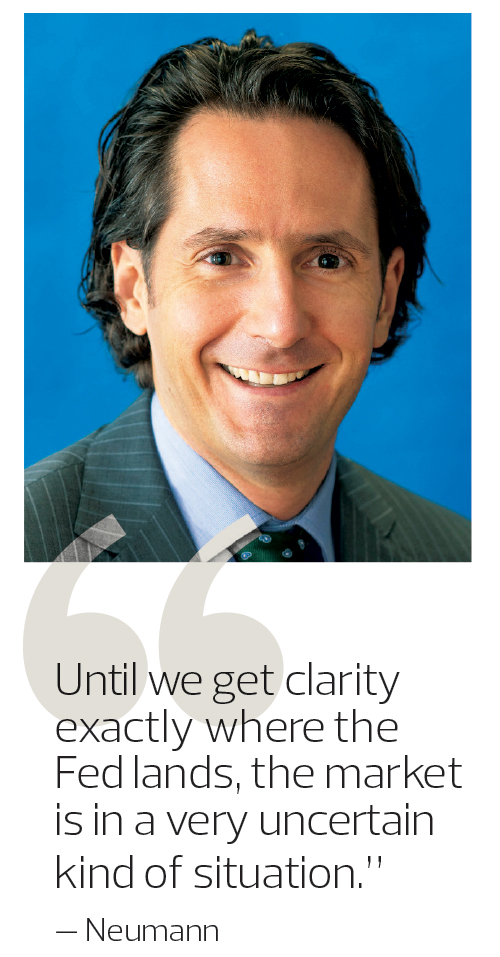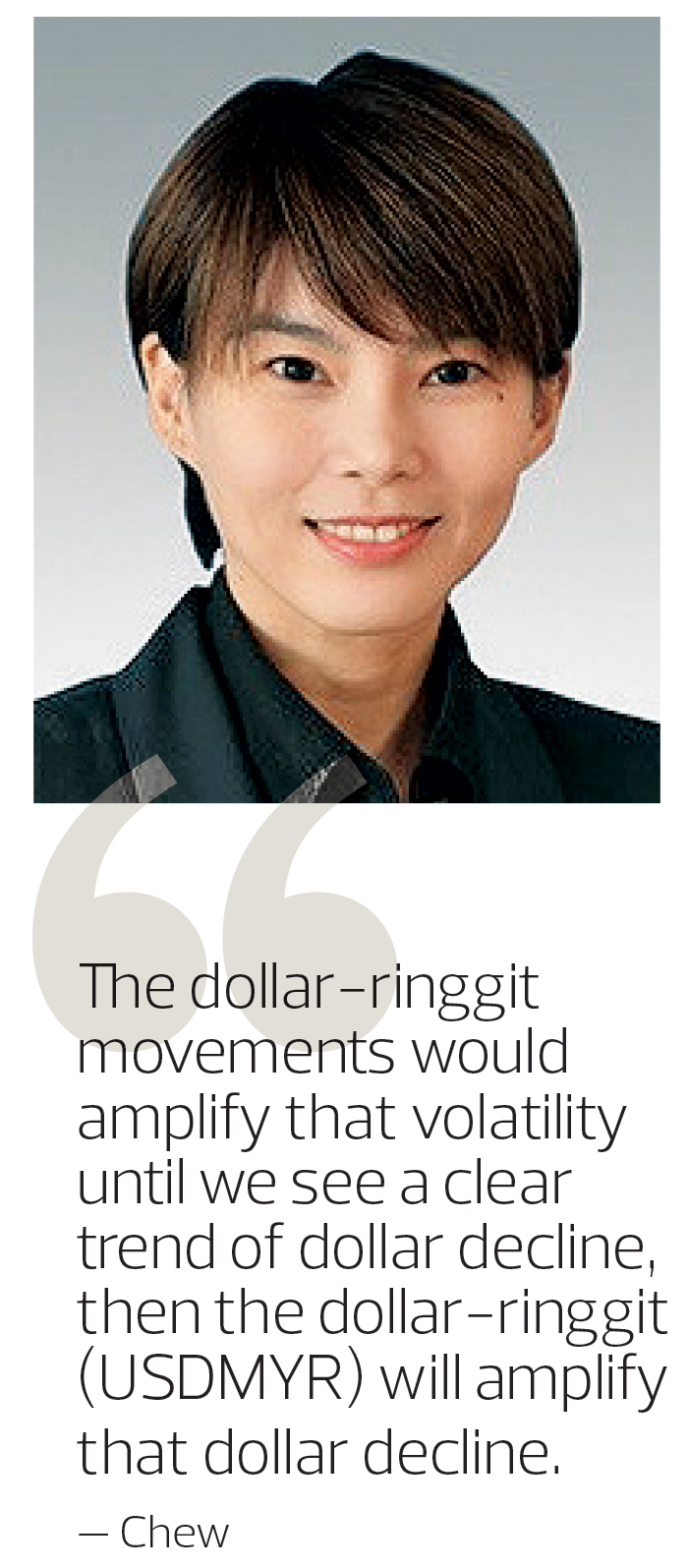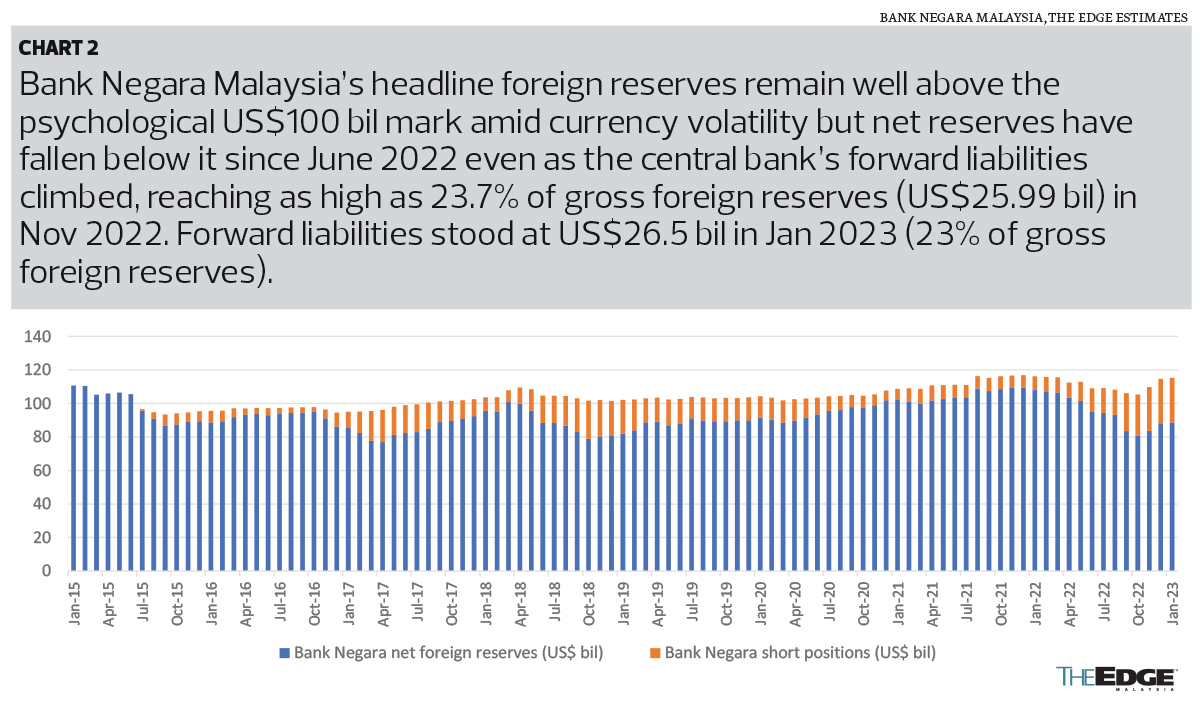
This article first appeared in The Edge Malaysia Weekly on March 20, 2023 - March 26, 2023
THE question of just how long the ringgit will stay undervalued might come up again this week, something that Bank Negara Malaysia may address next week when providing its guidance on the country’s economy at the release of its 2022 annual report on March 29.
Four out of five analysts polled expect the US Federal Open Market Committee (FOMC) to make its ninth consecutive interest rate hike this Wednesday (March 22), adding another 25 basis points to bring the fed funds rate to a range of 4.75% to 5% — that’s a cumulative 450bps hike in just one year since lift-off on March 16, 2022.
Bank Negara’s Monetary Policy Committee (MPC) only raised the overnight policy rate (OPR) by 100bps between May and November last year to 2.75%, before pausing rate hikes earlier than expected in January and continuing to hold rates at 2.75% at its second meeting this year on March 9. While a number of economists still expect another 25bps hike to 3% in the second half of this year, more are beginning to think Bank Negara is done tightening for now or would continue holding the OPR at 2.75% at its next meeting in May.
While that would further widen the US dollar-ringgit interest rate differential that is already at record-high levels, the country may just have to grin and bear it until there is certainty on whether the US Federal Reserve’s terminal rate is closer to 5% (where markets have priced in) or (dare we say) 6%, which would require further repricing.
What’s certain is global markets will move this week, and sway the ringgit along with it, should it become clear that there is need to price in a lot more rate hikes from the Fed in the next few months, with the market only pricing in fed funds rate of 4.9% and rate cuts as early as July, according to Bloomberg data at the time of writing (see Chart 1).
“There are two issues when you think about the Fed: one is how high would the Fed push rates and how long will they keep it there [and] the risk is the Fed putting rates higher than the market currently expects and keeping it up for longer than the market expects. Until we get clarity exactly where the Fed lands, the market is in a very uncertain kind of situation,” Frederic Neumann, chief Asia economist and co-head of HSBC Global Research Asia tells The Edge in Kuala Lumpur.
“When you look at core inflation in the US and labour market strength, clearly there is a case [for further rate hikes]. We’re at 5.25% now, [the terminal rate] could be higher than that. I don’t think it’s going to be 6.5% or 7% … we will find out over the next few months. It’s not going to be another year or two,” he adds.
There may not be much that Malaysia’s central bank is not already doing to smoothen the ride during this period of heightened uncertainty.
“The truth is that for currency markets, a lot of local idiosyncrasies mattered a lot less over the past 12 months because the broad dollar trend has just been so dominant. For the ringgit, notwithstanding the fact that Malaysia still has a decent current account surplus, tourism is recovering, which will help stabilise surplus further this year, [and] there is potential portfolio inflow because of the reform optimism. Notwithstanding all these things, the fact is that the broad dollar trend is in a difficult position to call,” says Joey Chew, HSBC’s head of Asia FX Research.
Noting that movements in the USDMYR have been more pronounced versus movements in the broad US dollar index in recent months, even when foreign investor portfolio outflows had been relatively subdued, Chew reckons that it may be because more local importers and foreign bond investors are actively hedging foreign exchange risk.
“Nearly 20% of corporate deposits are now denominated in foreign currencies from just 12% in early 2020 [before the export conversion rule was lifted]. Higher forex exposure requires more active management by corporate treasuries,” she adds.
To be sure, yield differential is not the only driver for a currency.
“For the ringgit, there are other drivers [for example,] a stable current account from a diversified export base, positive trade balance … Last year, there was a lot of forex hoarding. Deposits were rising because of the broad dollar trend … think about it, if the dollar is rising 10%, a yield differential of 1% is only 10% of that 10% — a small matter compared to the broad dollar trend. So, if the broad dollar trend reverses, even with yield differential, it might still make sense to convert [foreign currencies back to the ringgit]. That’s why expectations around the dollar matter a lot [and] the broad dollar trend is quite critical to this,” explains Chew, who does not think Bank Negara has reason to force exporters to convert most of their foreign currencies back to ringgit today. “[Unlike 2016], this time there is no need to be extra sensitive about the ringgit’s depreciation when basically the whole dollar-Asia [exchange rate] is moving.”
Nevertheless, Chew is of the view that the US-Malaysia interest rate differential “is quite large”.
“It is substantial. In the past, if it’s 0.5ppt or 1ppt, you wouldn’t think much of it but now the fed funds rate is 2ppt above the OPR. If it keeps rising, then naturally, you would start thinking about the carry you might lose. So I think the dollar-ringgit movements are amplified by [high FX holdings as well as record-size interest rate differential] and therefore dollar-ringgit could still continue to be quite volatile. We’ve already said that the dollar would be volatile. The dollar-ringgit movements would amplify that volatility until we see a clear trend of dollar decline, then the dollar-ringgit (USDMYR) will amplify that dollar decline,” Chew adds.
That Bank Negara’s forward FX short positions have risen substantially to reach 23% of total reserves since late last year may be related to the large interest rate differential (see Chart 2).
“[For] most central banks in Asia, reserves went down a little bit because of the rapid depreciation in currencies, [so] some central banks have had to smooth that depreciation, right? But Bank Negara managed to sort of restore its forex reserves back to the level they were before they started this smoothing, so that’s a good thing. The downside is that the short FX forward positions keep rising … the interest rate differential makes it such that forward points are so negative that it actually makes a lot of sense for certain investors, like foreign bond investors to FX hedge. There are very little foreign bond outflows in Malaysia but what we notice is that maybe they are forex hedging instead because forward points are negative … somebody must hold the other side [of the position] and that must be Bank Negara,” Chew elaborates.
Is the ringgit undervalued?
“One observation that struck me when speaking to clients [in Malaysia is that] a lot of issues brought up by the local SMEs (small and medium enterprises) are that inputs are expensive because the ringgit is weak. This leads me to think that most people still have this view that ringgit is undervalued because no one is complaining that ringgit is too expensive, therefore we cannot export, we cannot compete with Thailand, right? In fact, we are seeing the opposite: the ringgit is weak, so imports are expensive, therefore that makes us less competitive.
“So, from that angle, on the ground, there is still a sense that the ringgit is undervalued. Statistically, if you use models like long-term averages, obviously the ringgit is undervalued, right, because before 2016, the ringgit was 3.2/3.4/3.6. It’s only recently that it went above 4 [versus the greenback],” Chew adds.
At this juncture, Chew thinks there is still a chance that the ringgit could end at 4.20 to the greenback by year end. “[Going back to 3.80 USDMYR] is a very, very tough call. For now, let’s look forward to revisiting 4.20 again, which we touched in January. Look at how much the FX markets have moved. The ringgit went from 4.75 to 4.22 in a matter of three months [recently] and we have another 10 months to go. Who’s to say we can’t go from 4.50 to 4.20?”
The broad US dollar should resume its decline when volatility in US rates decreases, the risk of US hard landing recedes and there are green shoots of recovery in the global economy.
Save by subscribing to us for your print and/or digital copy.
P/S: The Edge is also available on Apple's App Store and Android's Google Play.
- Berkshire dismisses 'false' reports on Buffett comments after Trump shares video
- Trump’s TikTok plan upended by Chinese objections over tariffs — Bloomberg
- LTAT moving forward despite challenges
- US starts collecting Trump's new 10% tariff, smashing global trade norms
- Putra Heights disaster: King visits ground zero
- Second batch of Putra Heights fire victims get temporary vehicles
- My Say: Taking inspiration from bacterium: the devolution of power
- China says 'market has spoken' after US tariffs spark selloff
- US starts collecting Trump's new 10% tariff, smashing global trade norms
- Malaysian Highway Authority: 20km traffic jam on KL-Karak Highway as Raya travellers return




